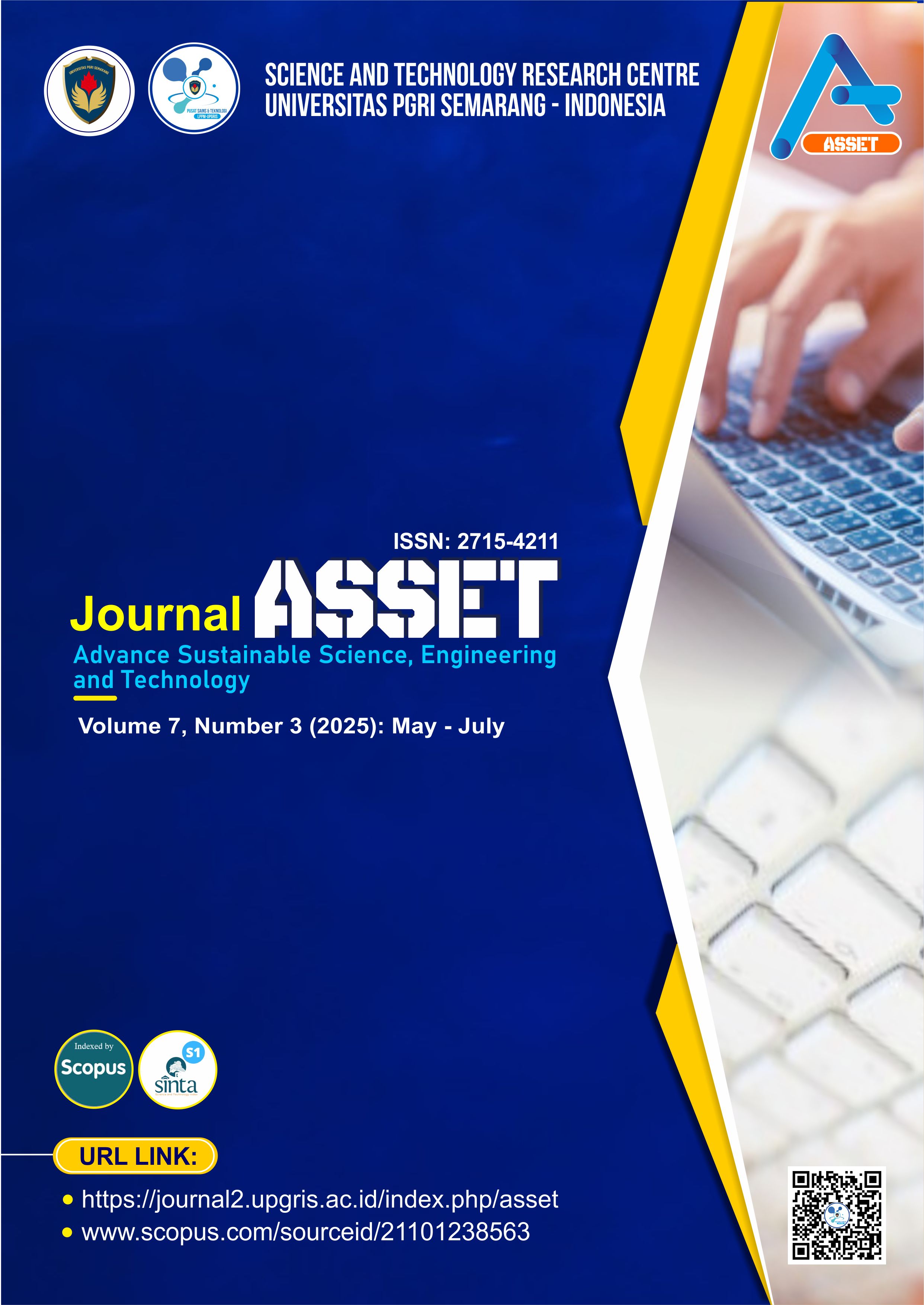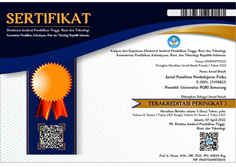Experimental Evaluation of Tali Bamboo Trusses with FRP Connections for Sustainable Structural Applications
DOI:
https://doi.org/10.26877/asset.v7i4.1975Keywords:
Tali Bamboo Reeds, Fiber Reinforced Polymer, Laminated Joints, Sustainable Materials, Structural TestingAbstract
Tali Bamboo is a local material that is widely utilized in traditional construction due to its availability, strength, and flexibility. However, weaknesses in the connection system are a major obstacle in its application as a structural element. This research aims to evaluate the strength and stiffness of tali bamboo joints using Fiber Reinforced Polymer (FRP) as joint reinforcement in plane trusses. The method used was experimental testing of three truss models with varying numbers of FRP laminate layers (1, 2, and 3 layers) combined with Polyvinyl Acetate (PVAc) adhesive and epoxy resin. Tests were conducted with center point loading to assess the performance of the connection. The results showed that the connection with 2 layers of FRP was able to withstand the maximum load optimally, or was able to withstand an average maximum load of 25.2 kN with an average deflection of 3.1 cm. The highest value reached 30 kN and a deflection of 4.0 cm, indicating optimal efficiency and strength. The physical properties of tali bamboo in the internode section are weaker than those in the book section, but still generally meet the criteria for structural materials. The implications of this study suggest that the use of double-layered FRP connections in tali bamboo can be an effective solution in improving the performance of plane truss structures, although further testing is required for more complex connections between truss elements.
References
[1] S. Aishwariya and S. Amsamani, “Exploring the potentialities and future of biomass briquettes technology for sustainable energy,” Innov Energy Res, vol. 7, 2018. https://doi.org/10.1016/j.conbuildmat.2018.12.198
[2] P. Astuti, A. D. Puspitasari, A. C. Fajar, A. Zulkarnain, and A. Y. Purnama, “Performance Evaluation of Seawater-Mixed Mortar under Carbonation Exposure for Sustainable Repair Applications,” Adv. Sustain. Sci. Eng. Technol., vol. 7, no. 2, p. 2502022, 2025. https://doi.org/10.26877/7k5s0e50
[3] J. Bredenoord, “Bamboo as a sustainable building material for innovative, low-cost housing construction,” Sustainability, vol. 16, no. 6, p. 2347, 2024. https://doi.org/10.3390/su16062347
[4] B. Ekanara, I. R. Lesmanawati, D. C. Sahrir, I. R. Isfiani, and N. T. Dung, “biokonservasi. id: A Development of a Conservation Education Website in the Mount Ciremai National Park as a Learning Resource,” Int. J. STEM Educ. Sustain., vol. 5, no. 1, pp. 1–26, 2025.
[5] M. Widyaningsih, S. Sriyati, W. Liliawati, and A. Mudzakir, “Ethno-Science Study of Bamboo as A Building Material of Baduy Community for Environmentally Friendly and Sustainable Materials Chemistry Learning,” J. Trop. Chem. Res. Educ., vol. 6, no. 1, pp. 48–63, 2024. https://doi.org/10.3390/polym14102051
[6] A. Akbar, M. Y. Sihabudin, R. E. Firdaus, and R. Pahreji, “Perkembangan Demokrasi di Indonesia,” Adv. Soc. Humanit. Res., vol. 1, no. 5, pp. 627–635, 2023. https://doi.org/10.3390/su16062347
[7] B. Irawan, M. Ihsan, M. D. Permana, and A. R. Noviyanti, “A Review of Bamboo: Characteristics, Components, and Its Applications,” J. Nat. Fibers, vol. 22, no. 1, p. 2522928, 2025.
[8] M. IHSAN, B. IRAWAN, and J. ISKANDAR, “The traditional ecological knowledge of the local people of Cijambu Village, Sumedang, Indonesia, on the diversity, utilization, management, and conservation of bamboo,” Biodiversitas J. Biol. Divers., vol. 25, no. 4, 2024.
[9] B. Galmarini, P. Costa, and L. Chiesi, “Natural building materials and social representations in informal settlements: how perceptions of bamboo interfere with sustainable, affordable, and quality housing,” Sustainability, vol. 14, no. 19, p. 12252, 2022. https://doi.org/10.3390/su16062347
[10] S. T. Dwijendra et al., “The Uniqueness of Architecture and Bamboo House Environment in Pengotan Traditional Village, Bali, Indonesia,” J. Soc. Polit. Sci., vol. 4, no. 1, 2021. https://doi.org/10.3390/su141912252
[11] A. G. Dananjaya, “Integrating Modern Sundanese Architecture in Mountain Villa Design and Planning for Tourism,” Adv. Civ. Eng. Sustain. Archit., vol. 7, no. 1, pp. 18–27, 2025. https://doi.org/10.9744/acesa.v7i1.14465
[12] R. Manandhar, J.-H. Kim, and J.-T. Kim, “Environmental, social and economic sustainability of bamboo and bamboo-based construction materials in buildings,” J. Asian Archit. Build. Eng., vol. 18, no. 2, pp. 49–59, 2019. https://doi.org/10.26877/7mhm6t05
[13] M. J. C. Aniñon and L. E. O. Garciano, “Advances in Connection Techniques for Raw Bamboo Structures—A Review,” Buildings, vol. 14, no. 4, p. 1126, 2024. https://doi.org/10.3390/buildings14041126
[14] S. Harahap, P. Y. Putri, R. R. Putra, T. Andayono, and L. Atika, “Perkuatan Struktur Beton Dengan Metode Frp Pada Bangunan Gedung,” Innov. J. Soc. Sci. Res., vol. 4, no. 3, pp. 9200–9214, 2024. https://doi.org/10.3390/polym14102051
[15] I. G. Bakri, “Eksplorasi Bambu Sebagai Material Berkelanjutan pada Bangunan,” J. Green Complex Eng., vol. 1, no. 2, pp. 69–78, 2024. https://doi.org/10.1088/1757-899X/673/1/012036
[16] Z. Zhang, X. Meng, J. Zhai, and P. Feng, “Experimental Study on Mechanical Properties of Bamboo Culms and Joints Reinforced with GFRP Sheets,” in International Conference on Fibre-Reinforced Polymer (FRP) Composites in Civil Engineering, Springer, 2021, pp. 1601–1613. https://doi.org/10.1088/1757-899X/673/1/012036
[17] O. O. Oyebamiji, A. S. Olaleru, R. B. Oyeleke, and L. N. Ofodile, “Evaluation and characterization of biochar and briquettes from agricultural wastes for sustainable energy production,” Waste Manag. Bull., vol. 3, no. 3, p. 100198, 2025.https://doi.org/10.1080/13467581.2019.1595629
[18] T. Setiawati, A. Z. Mutaqin, B. Irawan, A. ANAMILLAH, and J. ISKANDAR, “Species diversity and utilization of bamboo to support lifes the community of Karangwangi Village, Cidaun Sub-District of Cianjur, Indonesia,” Biodiversitas J. Biol. Divers., vol. 18, no. 1, 2017. https://doi.org/10.3390/polym14102051
[19] J. Kennaway et al., “Connection confinement of bolted fibre-reinforced polymer bamboo composite,” Polymers (Basel)., vol. 14, no. 10, p. 2051, 2022. https://doi.org/10.1080/13467581.2019.1595629
[20] H. B. B. Kuncoro, A. Awaludin, A. Triwiyono, and Z. Darwis, “Experimental study of variation of models and layers in bamboo’s perpendicular connection to fiber with fiber-reinforced polymer (FRP),” in IOP Conference Series: Materials Science and Engineering, IOP Publishing, 2019, p. 12036. https://doi.org/10.3390/polym14102051
[21] M. Yadav and A. Mathur, “Bamboo as a sustainable material in the construction industry: An overview,” Mater. today Proc., vol. 43, pp. 2872–2876, 2021. https://doi.org/10.1016/j.matpr.2021.01.125
[22] N. P. N. Pradhan and E. G. Dimitrakopoulos, “Pilot study on capacity-based design of multiculm bamboo axial members with dowel-type connections,” J. Struct. Eng., vol. 147, no. 5, p. 4021040, 2021. https://doi.org/10.1016/j.conbuildmat.2018.12.198
[23] P. Xu, J. Zhu, H. Li, Y. Wei, Z. Xiong, and X. Xu, “Are bamboo construction materials environmentally friendly? A life cycle environmental impact analysis,” Environ. Impact Assess. Rev., vol. 96, p. 106853, 2022.
[24] E. Suriani, “A study of the physical-mechanical properties of bamboo in Indonesia,” in Proceedings of the Built Environment, Science and Technology International Conference, 2020, pp. 154–162. https://doi.org/10.14421/jtcre.2024.61-05
[25] N. Santhosh et al., “Experimental Investigations on Static, Dynamic, and Morphological Characteristics of Bamboo Fiber‐Reinforced Polyester Composites,” Int. J. Polym. Sci., vol. 2022, no. 1, p. 1916877, 2022.
[26] L. Shen, J. Yang, R. Zhang, C. Shao, and X. Song, “The benefits and barriers for promoting bamboo as a green building material in China—An integrative analysis,” Sustainability, vol. 11, no. 9, p. 2493, 2019.











